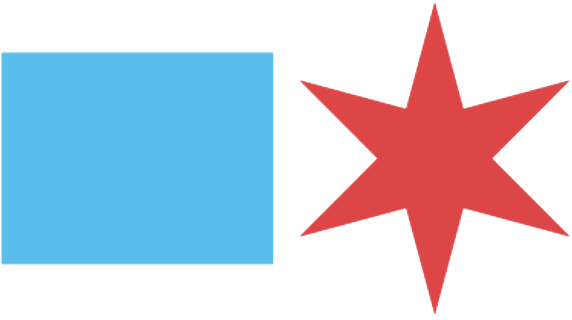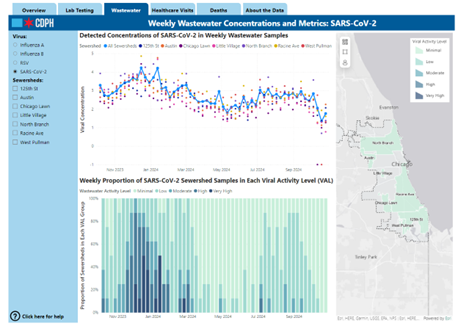Wastewater Monitoring
Wastewater Monitoring In Chicago
CDPH regularly assesses the levels of various infectious disease pathogens in wastewater, including SARS-CoV-2 (the virus that causes COVID-19), influenza viruses A and B, and respiratory syncytial virus (RSV). Wastewater (or sewage) contains human waste and can be used to track changes in the patterns of infectious diseases because, when someone is sick, the responsible infectious viruses or bacteria can be found in a person’s urine and/or feces. Moreover, infected people often “shed” this infectious pathogen into wastewater regardless of whether or not they have symptoms; in this way, wastewater data helps us to understand how infectious diseases in Chicago might be changing or spreading—even if they aren’t making people sick enough to go to the hospital.
Where is wastewater collected?
CDPH analyses wastewater data from various sites in Chicago, which all reflect unique sewersheds (or the geographic boundaries of a particular area where all wastewater flows to a single point). These sites are distributed throughout Chicago across all of the city’s 6 Healthy Chicago Zones.
- Three Pumping Stations, which serve populations ranging from 126,000 to 721,000 Chicagoans. Wastewater monitoring from these sites began in May 2023 and is sampled directly from wastewater entering the pumping station facility.
- Four Community Areas, which are distributed throughout Chicago and represent populations ranging from 29,300 to 83,400 residents. Wastewater from these sewersheds is accessed via manholes.
- Testing also occurs at specific high-risk facilities (including O’Hare Airport). This is the most ‘zoomed-in’ scale – it can be useful in the detection of new variants or for specific public health responses in large congregate facilities experiencing outbreaks of COVID-19. Because of their small and unique populations represented, these data are not included in overall citywide calculations of viral activity.
What does CDPH look for?
CDPH based its wastewater monitoring priorities on traditional disease “seasons” and emerging disease concerns.
- Regularly testing wastewater for the “Big Three” respiratory viruses (influenza, SARS-CoV-2, and Respiratory Syncytial Virus, or RSV).
- Intermittently testing for mpox virus at specific sites,
- Conducted a time-limited, three-month project to assess the utility of wastewater monitoring to track poliovirus.
How does CDPH use the data?
Concentration values are assessed alongside other forms of public health data in situational updates for respiratory season planning and protocol development at CDPH. CDPH teams utilize the information to help hospitals and providers plan for increased visits, support community testing needs. Chicago data is also shared with CDC partners and posted to their dashboard as part of the National Wastewater Surveillance System.
Current wastewater data, along with methodologic and analytic details, are available on CDPH’s Respiratory Illness Dashboard, which summarizes trends in respiratory disease within Chicago.
Wastewater Monitoring Dashboard
Data from Chicago's wastewater monitoring program can be found on the CDPH Respiratory Illness Surveillance Dashboard.
National Wastewater Surveillance System
Visit the National Wastewater Surveillance System (NWSS) website for more information.
Reports
Data from Chicago’s wastewater monitoring program can be found on the CDPH Respiratory Illness Surveillance Dashboard.
Annual Reports
- 2023 Wastewater Monitoring Annual Report
- 02/14/2023 - 2022 Molecular Surveillance Annual Report: English
Monthly Reports
- 03/23/2023 - Monthly Data report: Monitoring COVID-19 in Wastewater in the Chicago region: English
- 02/17/2023 - Monthly Data report: Monitoring COVID-19 in Wastewater in the Chicago region: English
Data Reports
- 01/18/2023 - Data report: Monitoring COVID-19 in Wastewater in the Chicago region: English
- 12/16/2022 - Data report: Monitoring COVID-19 in Wastewater in the Chicago region: English
- 12/01/2022 - Data report: Monitoring COVID-19 in Wastewater in the Chicago region: English
- 10/19/2022 - Data report: Monitoring COVID-19 in Wastewater in the Chicago region: English
- 8/22/2022 - Data report: Monitoring COVID-19 in Wastewater in the Chicago region: English
- 7/29/2022 - Data report: Monitoring COVID-19 in Wastewater in the Chicago region: English
- 6/21/2022 - Data report: Monitoring COVID-19 in Wastewater in the Chicago region: English
- 5/11/2022 - Data report: Monitoring COVID-19 in Wastewater in the Chicago region: English | Spanish
- 3/16/2022 - Data report: Monitoring COVID-19 in Wastewater in the Chicago region: English | Spanish
Partners
CDPH contracts with the Discovery Partners Institute (DPI), part of the University of Illinois System, which builds off work that began in 2020, funded by the Walder Foundation (read more about the Chicago Prototype Coronavirus Assessment Network Node here). In building this surveillance system, DPI coordinates expertise from multiple partners to identify possible collection sites, collect samples, conduct SARS-CoV-2 testing and quantification, and conduct genomic sequencing to identify variants in wastewater samples. These partners include other City departments (e.g., the Department of Streets and Sanitation), the Metropolitan Water Reclamation District of Greater Chicago, and scientists at Northwestern University, Argonne National Laboratory, and the University of Chicago.






